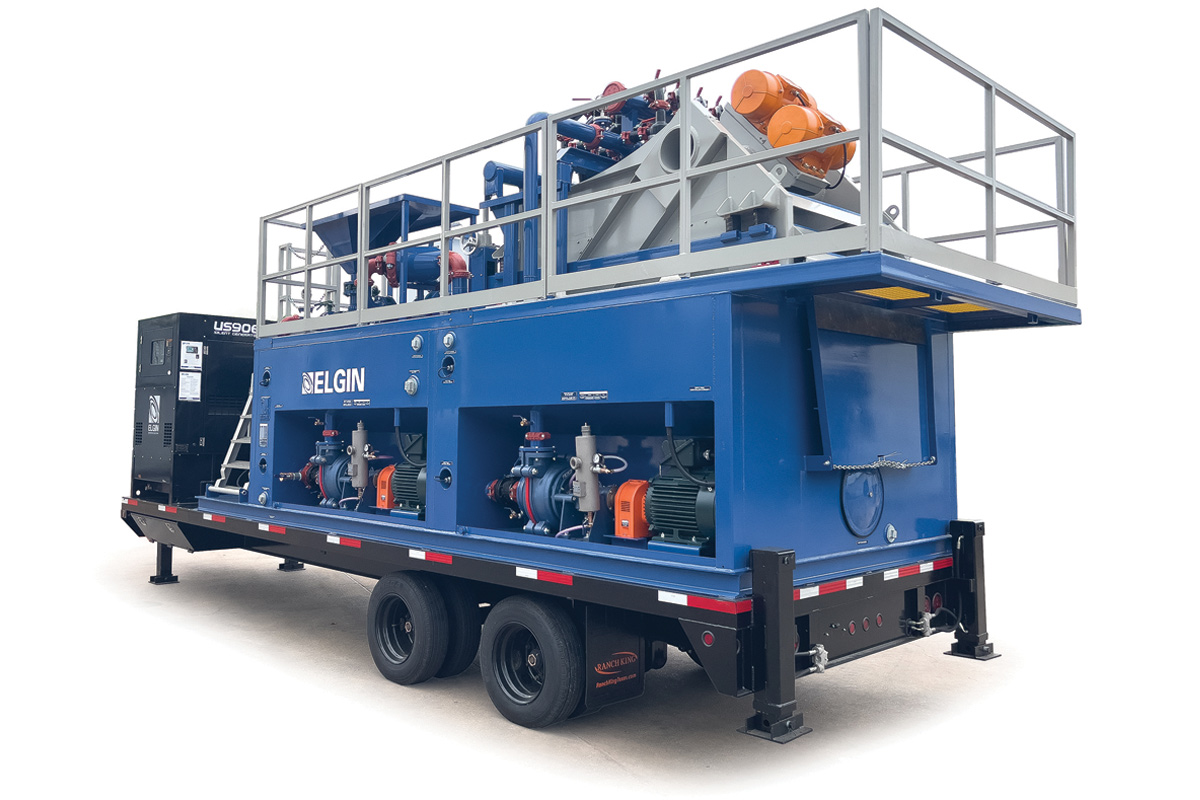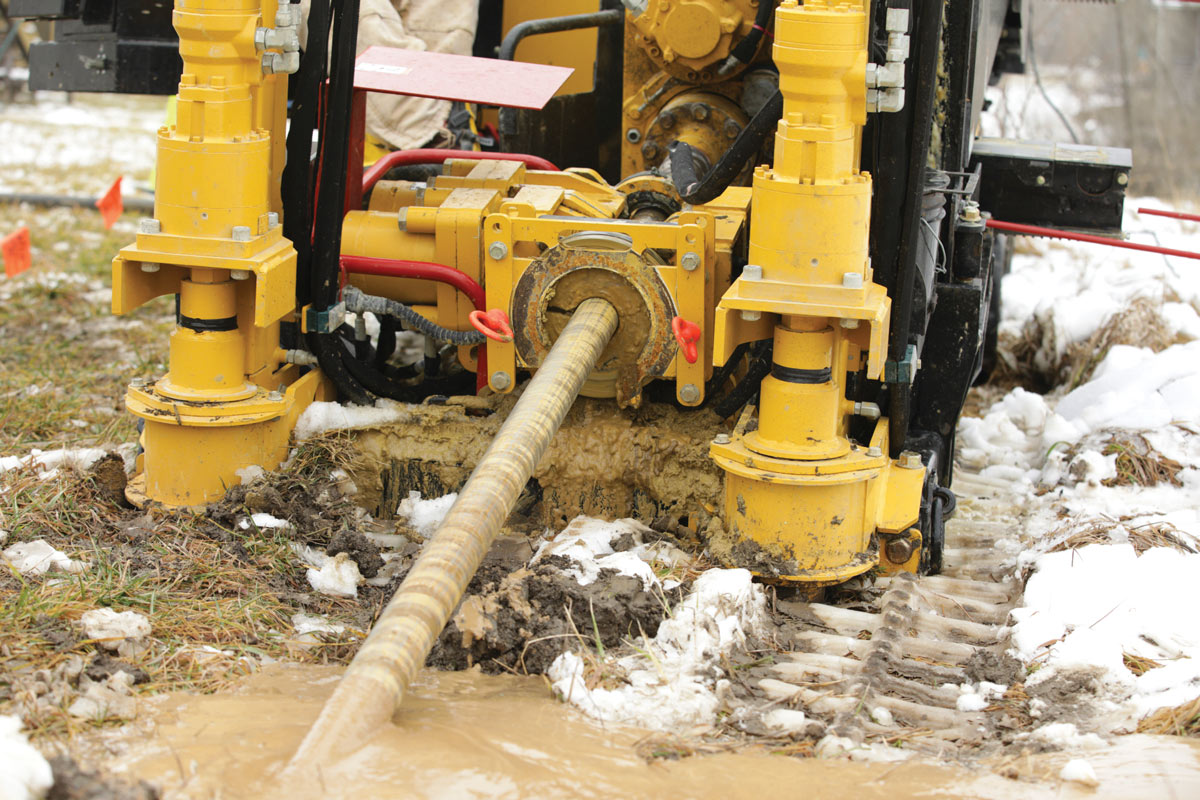
Not Your Typical HDD Fiber Install

Cranes expertly lift the pipe into position. The Dura-Line FuturePath reels are positioned on both sides of the pipeline in preparation of the pullback.
In the oil and gas industry horizontal directional drilling is a preferred crossing method to minimize potential impacts to the environment and stakeholders in sensitive areas, such as when the pipeline route must cross a waterway or wetland. This methodology is exactly what Enbridge selected for their Norlite Pipeline project in Alberta, Canada.
The Norlite Pipeline is a 277-mile, 24-in. diameter diluent pipeline stretching from Enbridge’s Stonefell Terminal, in Strathcona County, Alberta, and ending at Enbridge’s Fort McMurray South Facility. The pipeline project includes five major watercourse HDD crossings broken down into six different sections (spreads). Spread 1, completed in October 2016, is a 0.6-mile shot that required the expertise of Enbridge’s construction and leak detection crews, the engineering skills of Stantec and the proficiency of contractors Banister Pipelines, Michels Canada and Chemco.
RELATED: Microtunnelling Under the Mary Hill Bypass
The reason for the extra attention? Enbridge Pipelines selected this river crossing for a real-world implementation of external leak detection that uses fiber-optic cables. That’s right, the same technology that is used to bring blazing-fast Internet speeds to your home or office is being adapted to the oil and gas pipeline sector to help improve leak detection and real-time pipeline data gathering.
The fiber-optic systems can monitor the pipeline continuously in real-time to detect leaks in the pipe, abnormal conditions and other ground disturbances around the pipeline. This data is invaluable where a pipeline is located in a high consequence area, an area prone to erosion or where a person might mistakenly dig in the right-of-way. Since 2012, Enbridge Pipelines has explored external leak detection as another piece in its asset management tool box.
“We had the idea to complete a river crossing back in 2013, but recognized the many aspects to be considered and decided we were not ready at that time. Planning for the Norlite fiber-optics installation began in December 2015 when we were speaking about the North Saskatchewan River as a high-consequence area along the pipeline route,” says Jim Bazeley, manager, construction, regional pipeline projects, Enbridge Pipelines. “Several systems were considered and evaluated to potentially enhance our leak detection capability in that area, including several cable-based technologies [distributed acoustic and temperature fiber sensing, hydrocarbon sensing cables and vapor sensing tubing]. For this application, we selected a fiber-optic system as we felt it most closely met the requirements.”
RELATED: Canada Pipeline Project Turns to Trenchless
Bazeley refers to the North Saskatchewan River crossing as a, “technological breakthrough that will eventually add another reliable layer of safety in the pipelines industry.”
“The fiber should be installed close to the pipe so we can get a strong signal,” Bazeley says. “We need to protect that fiber during installation, and this is why we needed the conduit.”
Enbridge reached out to its fiber suppliers Anixter and Corning and potential vendors of fiber-optic leak detection to discuss what is possible and what has been accomplished before, ultimately turning to the telecommunications industry and its use of high-density polyethylene (HDPE) conduit. Microduct HDPE is made up of multiple small HDPE conduits, or “ducts”, tightly bundled and bound together with a durable sheathing. Enbridge selected Dura-Line’s FuturePath microduct for this Norlite crossing.

The custom pulling eye includes the additional tubes to encompass the FuturePath connections enabling them to remain close to the product pipe.
“To make this a success, we needed the right engineering, the right materials, and then the right contractors with enough experience to execute on it. Our team determined how to pull a conduit with this delicate glass fiber optic sensor inside while considering all the other aspects of this HDD — the weight of the 966-m heavy-walled steel pipe, the pressure of the HDD mud inside the bore 115 ft under the North Saskatchewan River and the hundreds of thousands of pounds required to pull the pipe and conduit through the hole,” Bazeley says. “It requires a lot of different factors to be understood, all at once. The speed of pullback has to be tightly controlled because the steel-pipe, the conduit, and the fiber inside the conduit bend and stretch at different rates, and each has a different breaking point. As well, the steel pipe often rotates inside the hole during a longer HDD pullback, or the pullhead may catch on a layer of rock or pinch the conduit against the edge of the bore. The amount of mud deep inside the bore affects friction and whether the steel pipe and the conduit will float to the top or sink to the bottom. Any misjudgement in these areas could complicate the entire operation.”
One of most important preparations was to make a secure connection between the conduit, the pipe, and the HDD rig to ensure the steel pipe comes through with the conduit and fiber intact. “Over the past few years our engineers saw a few different pull-heads that were used on shorter pulls. We took the requirements to our contractors and they really improved upon anything we’d seen in the past. A rule-of-thumb in the trenchless industry is that a hole should be 1.5 times the size of what you are pulling through. With this design, and making few trade-offs, we could accommodate the conduits without increasing the bore.”
With guidance from Dura-Line and the expertise of Stantec, Entec, Banister Pipelines and Michels Canada, a unique pull head was designed that would piggyback two Dura-Line conduits into the borehole — one on each side of the steel pipe. The pull-head resembles Mickey Mouse ears and kept the conduit close to the pipe without having to increase the bore to accommodate the two conduits.
“A number of groups have provided input to this over the past few years. Many individuals were consulted and provided support to get Enbridge to where we are now,” Bazeley says. “We spoke with researchers, vendors and contractors on previous pipeline construction projects, consulted EPCs from across the globe with experience designing fiber-optic systems, and leveraged industry expertise provided by our suppliers Anixter, Corning, and Dura-Line.”
The pullback was completed successfully and Enbridge is working to complete the entire Norlite Pipeline. At this time, the fiber-optic leak detection portion under the North Saskatchewan River is not yet turned on. When it is, Enbridge will spend an extended amount of time fine tuning the network to make sure it is confident in the data that is being provided.




